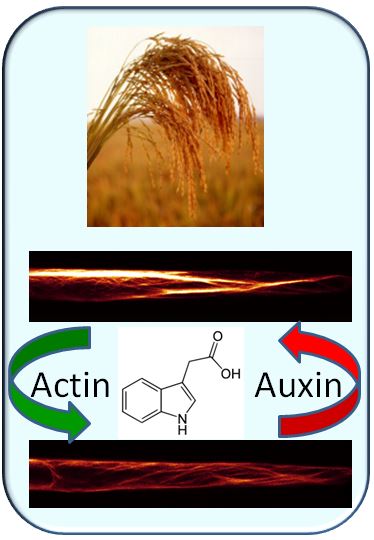Auxin steers its own transport via Actin
Publication
75. Nick P, Han M, An G (2009) Auxin stimulates its own transport by actin reorganization. Plant Physiology 151, 155-167 (selected for the Faculty of 1000, 21.10.2009) (78 quotations, state 27.09.2019) - pdf
What is the topic?
Actin is the building block of our muscles. Why also plants produce this muscle protein, is far from understood. After several years of work we found a link between actin organisation and the regulation of cell growth. In growing cells, actin filaments are organised in fine strands, in cells that have stopped to grow, they are instead bundled into thick cables. To understand this in more depth, we have generated in cooperation with colleagues in Korea transgenic rice plants, where the actin firlaments are all the time bundled by overexpression of the protein talin. This protein does not occur in plants, but causes actin bundling in mammalian cell. Talin was labelled by the fluorescent protein YFP (for Yellow Fluorescent Protein). We obtained different lines that expressed more or less of the talin-YFP fusion. When the abundance of this protein was low, we observed fine, fluorescent strands of actin that were dynamic, and these plants behaved normally. However, when higher levels of talin-YFP were produced, actin was heavily bundled, the "plant muscles" were apparently in continuous tension. These plants also had problems with growth, and were also not able to bend in response to gravity, when they were tilted. This so called gravitropism requires a functional transport of the plant hormone auxin. We therefore tested, whether auxin transport was perturbed by talin-YFP. We added radioactively labelled auxin to the tip of seedlings and measured the radioactivity arriving at the base after a given time. In fact, the "muscle contraction" caused by the overexpression of talin-YFP, strongly reduced auxin transport. By adding additional auxin, we could, however, rescue a normal organisation of actin, and this rescued (as expected) also the ability for normal transport of auixn.
This work demonstrates therefore that auxin, through modulating actin filaments, can steer its own transport.

